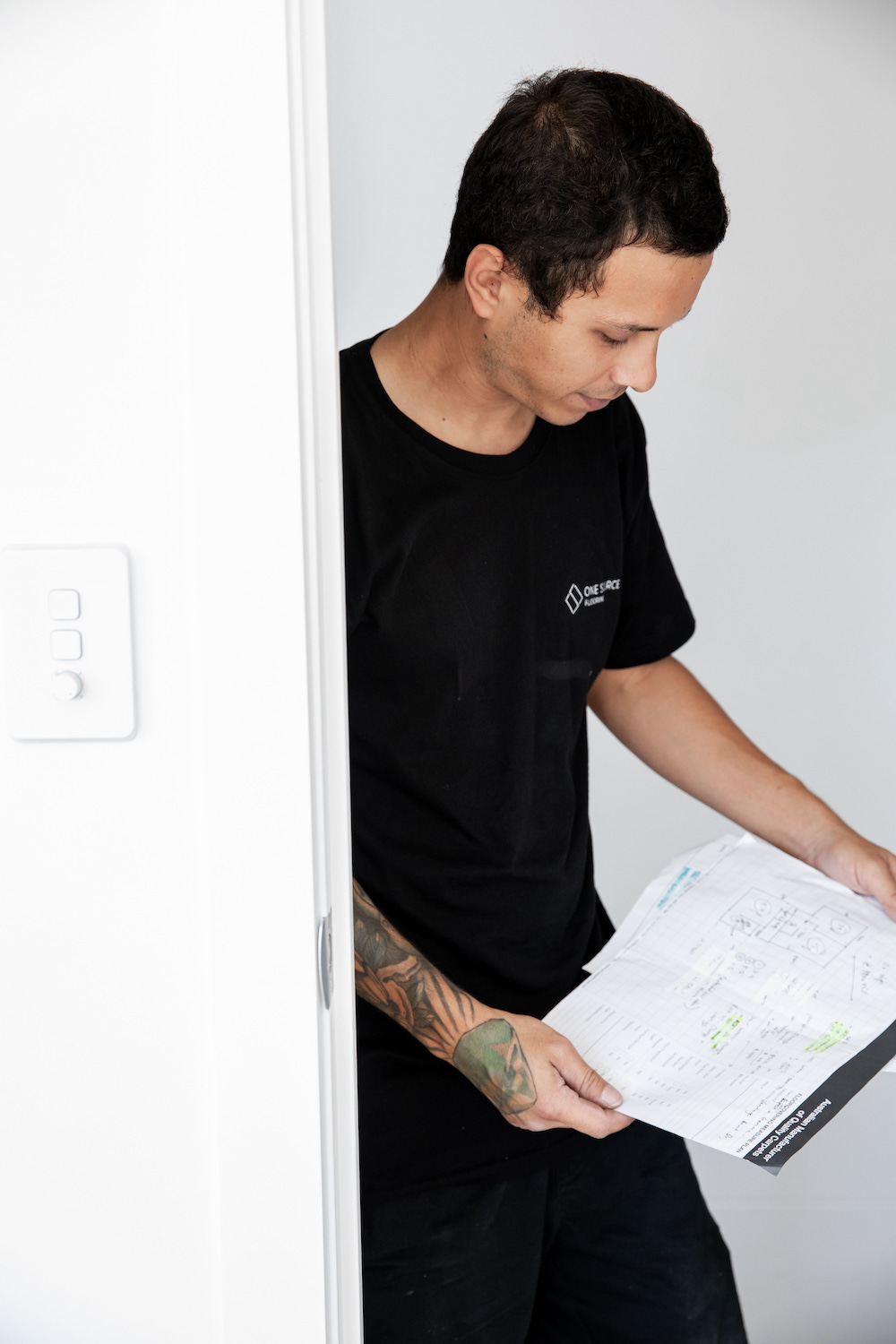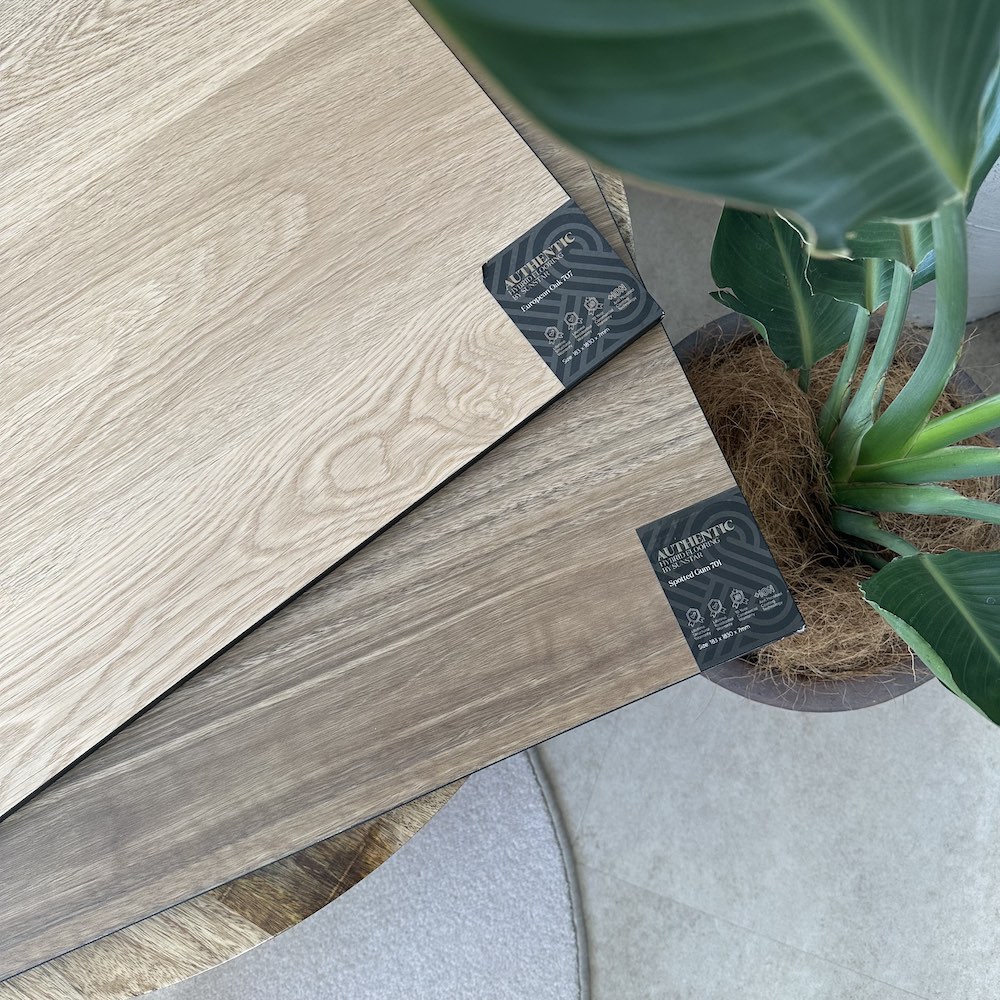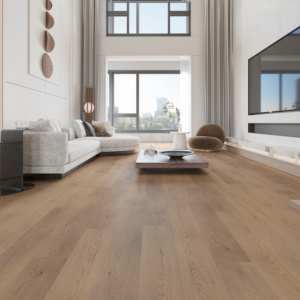As the name suggests, hybrid flooring was developed by combining qualities from other flooring types, creating an entirely new flooring solution that’s low maintenance and durable. Hybrid planks gained popularity in the early 2020s due to their ease of installation (floating over existing flooring) with many manufacturer’s claiming their products are waterproof and suitable throughout your entire home. However, in recent times, we have seen that hybrid planks aren’t the one-size-fits-all flooring solution that was once promised, so it’s important to know where hybrid has its place compared to other solutions like engineered timber, laminate flooring, or vinyl flooring.
What is hybrid flooring made of?
Generally, hybrid floors consist of:
Underlay (or Backing) – The construction of this layer can vary between brands, but usually consists of foam or cork. This layer enhances walking comfort, warmth and minimises sound transmission. By having this layer attached to the product, you generally do not need any additional underlays.
Middle Layer – This varies from product-to-product, but more commonly consists of a waterproof core. This can be constructed from a ‘Stone Polymer Composite (SPC)’ which combines limestone, Polyvinyl Chloride (PVC) and stabilisers, or ‘Wood Plastic Composite (WPC)’ which, you guessed it, combines recycled wood and PVC. SPC is slightly more durable, while WPC is slightly quieter underfoot. You may also have heard of RCB, or Rigid Core Board. This is relatively new technology that is manufactured from inert mineral compounds that are stable and provide little or no movement.
Decorative Layer – It is this layer that is designed to replicate the look of timber, oak, concrete or stone.
Surface Layer – This layer provides extra protection from everyday wear and tear.
UV Layer – You’ll also find most products have UV-resistant qualities, making it a good option for all sun-exposed areas in your home.
Pros and Cons of Hybrid Flooring
Hybrid Flooring Pros
- Durability: Hybrid is durable and resistant to minor scratches, stains, and fading, making it ideal for high-traffic areas.
- Easy maintenance: Hybrid flooring is easy to clean and requires minimal maintenance, usually just requiring regular sweeping and occasional dry mopping.
- Aesthetic appeal: Hybrid comes in a wide range of styles and designs, mimicking the look of natural materials such as wood or stone.
- Comfortable underfoot: Many hybrid flooring options come with attached underlayment, providing additional cushioning, making it comfortable to walk on.
- Versatility: It can be installed on various subfloors, including concrete, plywood, and existing flooring, making it suitable for renovations.
- Longevity: With proper installation and maintenance, hybrid flooring can last for many years, providing excellent value for money.
Hybrid Flooring Cons
- Not Entirely Waterproof: Most hybrid planks are not entirely waterproof and only have a waterproof surface.
- Cost: Hybrid can be more expensive that other options once you factor in floor preparation and perimeter finishes.
- Perimeter finishes: Unlike vinyl, hybrid perimeters cannot be siliconed and you will need to consider replacing and reinstalling skirting or installing a scotia beading.
- Limited repair options: Unlike timber flooring, hybrid cannot be refinished or individually replaced like vinyl.
- Potential for fading: While hybrid flooring is resistant to fading, prolonged exposure to direct sunlight can cause some designs to fade over time.
- Weak locking mechanisms: Cheaper hybrid from major retailers often have weaker locking mechanisms, resulting in separation between planks when not installed properly.
- Ramping: In homes with varying floor levels, you cannot ramp with rigid planks like you can with vinyl.
- Heavy furniture can damage hybrid flooring over time.
Hybrid Flooring Colours and Styles
Hybrid flooring comes in a range of colours, styles and finishes. You can choose from timber, oak, concrete and stone-look hybrid, with ranges designed to mimic not only the look of, but also the feel of natural woods and stones. Scroll through some of our favourites below.
Hybrid Flooring Installation & Floor Preparation
Hybrid flooring is a ‘floating floor’ and as such, does not need to be glued or nailed down. It is a popular choice as in most cases, you can float the planks over your existing hard flooring without the need to remove it. Here are some important installation factors you need to consider:
- If you’re choosing to lay over tiles, they will need to be inspected first to ensure that there aren’t any ‘drummy’ or damaged, as tiles can pop/lift later on down the track, ultimately damaging your new floors.
- Most hybrid flooring sold at One Source Flooring comes in a form of ‘click’ install, so they cannot be individually lifted and replaced if damage does occur. If a plank (or multiple planks) does become damaged, you will need to remove all of the planks from the edge of the space until you reach the damaged plank. Hybrid plank joins aren’t necessarily designed to be installed, un-installed and then re-installed so this can interfere with the longevity of your floor.
- You will also need to consider how your flooring will need to be finished around the perimeter of the room and anywhere where the floor meets, like your kitchen kicks, benches etc. Hybrid planks require an expansion gap that cannot be siliconed so you will need to reinstall new skirting boards or scotia beading.
- Depending on the brand you’ve selected, your hybrid planks are also limited to a specific span length. So if you have a long hall that heads to your living area, you may need to install (unsightly) joins.
- Most importantly, hybrid flooring does require some level of floor preparation prior to installation. Hybrid flooring also as specific deviation tolerances, so we recommend that you engage with a professional floor installer (like One Source). When installing hybrid plank flooring you may require the installation of a moisture barrier, levelling compounds and or grinding before installation. When done by a professional, you will have confidence that your floor has been installed correctly and benefit from our 5 Year Installation Guarantee and any Manufacturer’s Warranties.
Installing Hybrid Flooring
As professional flooring installers we, of course, are going to recommend choosing an experienced installer to lay your hybrid flooring. But there’s some pretty important reasons behind why it’s really not a bad idea:
- We offer a 5 Year Installation Guarantee, so if anything should go wrong with your hybrid flooring installation, we’re local and are able to help.
- Our installers are professionals and are hand-picked due to their experience in the industry. They have the expertise to ensure that your hybrid flooring installation has been done properly – allowing you to maintain your manufacturer’s guarantees/warranties.
- Rest assured that your levelling and expansions have been done correctly, avoiding costly relaying expenses. We have a great blog on how to avoid a DIY Disaster.
We cover some super helpful tips in our FAQs on our Hybrid page .
If you’d like to know more about our professional hybrid flooring installation service, fill out our free in-home measure and quote form.

Final tip — How to Clean Hybrid Flooring
We suggest using PureFlor hard surface cleaner on your new hybrid floors. It is Australian-Made, contains only natural ingredients in a concentrated formulation, is pH neutral, non-toxic and removes the toughest stains by destroying organic stains, soils and odours at source. We suggest using a damp cloth or mop, not a wet one. Do not steam mop your new hybrid floors.
If you’d like to know more about hybrid flooring or to book a free measure and quote, complete your on our quote page and we’ll be in touch.




























































































































































